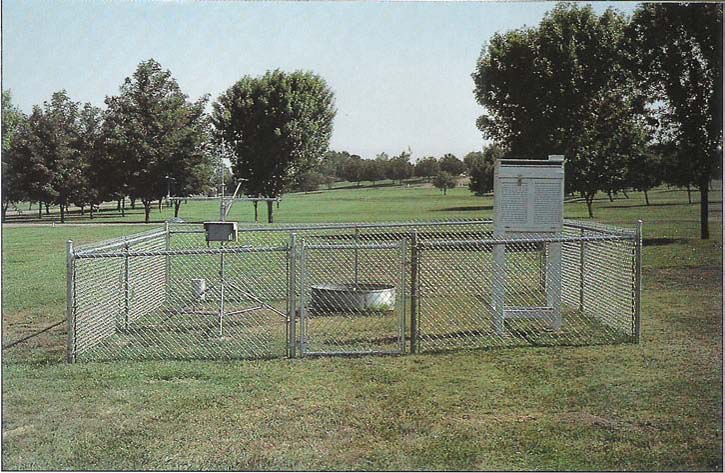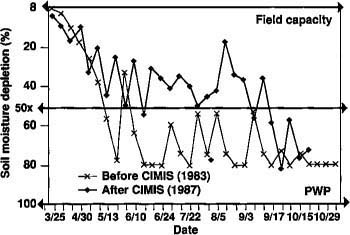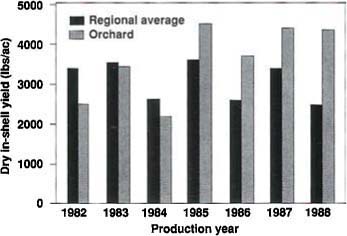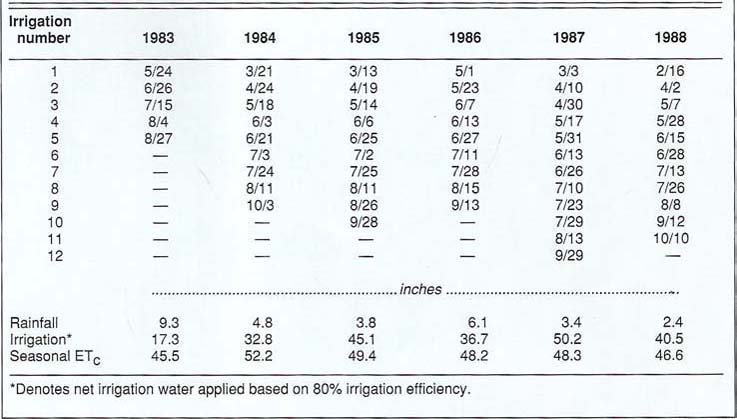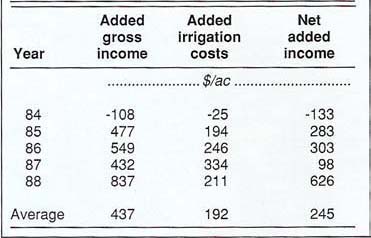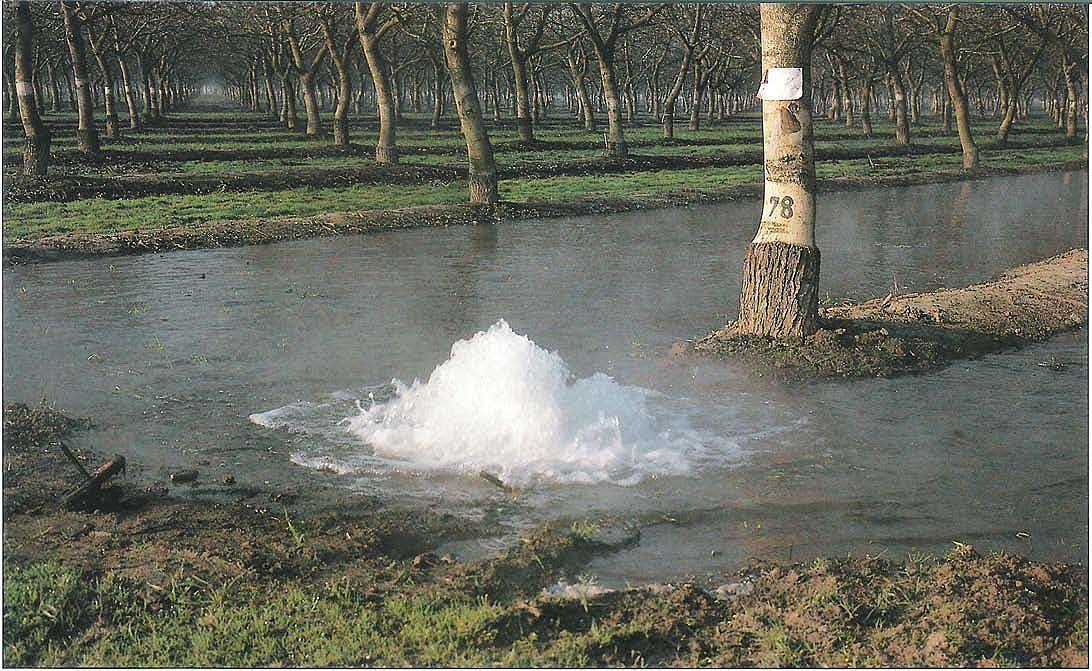All Issues
Implementing CIMIS at the farm level: a grower's experience in walnuts
Publication Information
California Agriculture 45(5):38-40.
Published September 01, 1991
PDF | Citation | Permissions
Abstract
The California Irrigation Management Information System (CIMIS) originated in 1982. Its purposes were to provide estimates of crop water requirements as influenced by real-time weather conditions and to ensure reasonable use of limited water supplies for farming. This study documents the effects of managing on-farm irrigation practices, with and without using CIMIS information, in a Kings County walnut orchard. In this example, increased water use, increased production, and increased profits were experienced as a result of implementing CIMIS information.
Full text
Daily information from the Dudley Ridge CIMIS weather station was used to estimate water requirements for mature walnuts, as well as irrigation timing and quantity.
It has been charged that existing irrigation practices on agricultural lands in California use limited water supplies inefficiently. In partial response, the California Irrigation Management Information System (CIMIS) was initiated in 1982 to ensure reasonable use of limited water supplies on agricultural croplands. Objectives of the CIMIS program have been to provide estimates of crop water requirements based upon real-time weather conditions and to promote adoption of CIMIS information into the irrigation scheduling practices of growers in California.
CIMIS consists of a network of about 65 automated weather stations located throughout the state. Under the management of the California Department of Water Resources' Office of Water Conservation, hourly weather data is logged from each station onto a mainframe computer in Sacramento. The public can obtain this information by calling the Department of Water Resources at (916) 445-8259, by contacting public water agencies, or by referring to various publications.
Real-time weather measurements taken at each station include solar radiation, maximum and minimum temperature, wind speed, vapor pressure (a measure of humidity), and rainfall. These climatic parameters, except rainfall, are used to estimate a daily rate of evapotranspiration for a well-maintained, unobstructed pasture consisting of 4- to 6-inch tall cool-season grasses. Reference evapotranspiration (ETo) can be used to estimate crop evapotranspiration (ETc) for a variety of agricultural commodities by correcting the ETo with an appropriate crop coefficient (Kc). Crop coefficients have been developed for agronomic and horticultural crops which reflect the differences in crops, planting dates, crop development stages, and proportion of ground shading.
In previous controlled studies, UC scientists established crop coefficients for walnuts. They also showed that walnuts were sensitive to water stress and responsive to adequate irrigation. For example, when trees received only 66% of their full water requirement for 3 consecutive years, walnut yield dropped 35%. (For further details, see Walnut Research Reports, 1986-1990, Walnut Marketing Board, Water Management Section.)
Because some growers underirrigate walnut orchards, CIMIS recommendations may not always result in reduced water use; CIMIS simply predicts the water requirement for adequately irrigated crops such that yield and quality are not impaired by low water availability. In practice, however, a grower's irrigation management will take other factors into account, namely the price and availability of water, environmental costs and limitations, and the recent history of drought or wet years.
The objective of this demonstration project was to apply previously-developed UC research to walnut cultivation on one farm over the course of several years.
Implementation procedures
To help introduce the statewide CIMIS program, UC scientists conducted an on-farm demonstration from 1983 to 1988 in a Kings County commercial walnut orchard. Objectives of the demonstration were: 1) to document the original irrigation practices in the orchard, 2) to implement appropriate changes in the original irrigation practices based upon CIMIS information and 3) to document orchard responses to modifications of the original irrigation management.
A 27-acre Serr walnut orchard on paradox rootstock (J. hindsii x J. regia) was selected in 1983. The orchard had been established since 1972. Soil types included the Grangeville fine sandy loam, Nord fine sandy loam, and Whitewolf coarse sandy loam. A border flood irrigation system with one valve per basin was used. Basin dimensions were 600 x 30 ft with no slope across the borders and 0.03% grade down the basin. Irrigation water was provided from the Kings River with supplemental water from shallow wells. Native vegetation on the no-till orchard floor was controlled by mechanical mowing. Annual rainfall ranged from 2.4 to 9.3 inches at the demonstration site.
Irrigation practices
Farm records of applied water and irrigation dates were reviewed for the 1982 and 1983 seasons. These records reflected water management without CIMIS information. Then, a CIMIS-based water budget, as described in the following paragraph, was implemented from 1984 through 1988.
Weekly ETc was calculated using estimates of reference evapotranspiration from a nearby CIMIS station and walnut crop coefficients for the San Joaquin Valley. The effective root zone used for water budgeting was 5 ft deep. Available water holding capacity in the root zone was 8 inches. Starting in 1984 under CIMIS-based management, irrigations were scheduled when ETc accumulated to about 4 inches after the previous irrigation.
Depths of applied water per irrigation were assessed in six basins during 1983 and 1984. Inflow, set time, water advance and recession were monitored to determine the cumulative depth of infiltrated water. Water advance rates were constant with distance down each basin suggesting slow initial rates of water infiltration. Full water advance was achieved in about 1 hr, and irrigations into each basin were shut off after about 2 hr to prevent runoff. Water recession was slow, requiring between 72 and 96 hr.
Irrigation efficiency (ETc/applied water) was evaluated at 80%. Primary losses were due to surface evaporation from long-standing water and nonuniform water infiltration (distribution uniformity evaluated at 80%). Applied water ranged from 4.3 to 5.2 inches irrigation. After allowing for inefficiencies inherent in the irrigation method, infiltrated water ranged from 3.6 to 4.5 inches/irrigation.
Percent depletion of the available water between irrigations was measured at 9 neutron probe monitoring sites. Access tubes were placed near the head, center, and at the end of three tree rows distributed across the orchard. Readings were taken to a 9-ft depth in 1-ft increments on a weekly basis to clearly define the effective root zone.
TABLE 1. Irrigation schedules, annual rainfall, net irrigation water*, and seasonal ETc from 1983 through 1988
Cultural practices
Nitrogen fertilization ranged from 132 to 155 lb/ac during the evaluation period. The highest nitrogen rate was applied during the 1983 baseline year when efforts were made to increase tree growth through improved fertilization. Insect damage was low irrespective of CIMIS implementation.
Yield and quality
Walnut production and quality responses were recorded annually from the commercial harvests. Total yield and nut quality parameters (size, edible yield, shrivel, mold, and insect damage) were compared to regional production records for the same variety annually.
Profitability
A partial budget analysis was used to evaluate effects on profitability. Changes in profitability were determined by comparing irrigation-related costs and income before and after implementing CIMIS. Since walnuts show alternate bearing tendencies, costs and income from 1982 and 1983 were used as baselines. Hence, production figures for off-bearing years (1984, 1986, and 1988) were compared to the 1982 baseline and for on-bearing years (1985 and 1987) were compared to 1983. Irrigation costs related to the revised practices included additional water costs ($25/ac-ft), irrigation labor ($6.50/hr), pruning ($20/hr) and harvest costs ($0.10/lb) for increased production. Profitability was computed by subtracting the increased costs associated with irrigation from the additional gross income.
TABLE 2. Added profits attributed to improvements in the original irrigation practices from 1984 through 1988
Results and discussion
Irrigation scheduling
The irrigation schedules and net applied water before and after implementing CIMIS are presented in table 1. Review of irrigation records from previous seasons indicated that 1983 practices were representative. Net water applied to the orchard in 1983 from rainfall and five irrigations was 26.6 inches. Estimated ETc for the same period was 45.5 inches indicating that only 58% of the water requirement was met.
Following CIMIS implementation, the number of irrigations and net applied water increased two-fold in 1984. This increase was still 28% less than the seasonal ETc because of grower skepticism about CIMIS estimates and concern about over-irrigation. Continued CIMIS implementation increased the applied water to nearly three times that applied previously. Irrigation water and rainfall from 1985 through 1988 satisfied 99, 89, 111, and 92% of the seasonal ETMc, respectively.
Figure 1 illustrates seasonal soil moisture conditions before CIMIS (1983) and after (1987). During 1983, a 54-day interval between leafout and the first irrigation reduced available soil moisture to 75% depletion. Slow water infiltration characteristics prevented refilling the available water in the root zone and infrequent irrigation scheduling sustained dry soil-water conditions from early June to the end of the season.
After CIMIS, water content of soil was consistently maintained above 50% depletion of available water until the irrigation schedule was compromised for harvest preparation. Fluctuations in soil water content were less extreme under CIMIS management as compared to the original practices. Also, a postharvest irrigation reduced the dry soil-water conditions late in the season.
Yield and quality response
Dry in-shell yields for 1982 through 1988 are presented in fig. 2. Before implementing CIMIS (1982-1983), dry in-shell yields were 2 to 27% less than the regional average for the Serr variety. After implementing CIMIS (1985-1988), dry in-shell yields ranged from 31 to 75% above the annual, regional average. An absence of increased yield during the first year of implementing CIMIS (1984) reflects the one year of enhanced tree growth required to increase the number of fruiting positions before added nut production is realized. Although nut quality showed only a slight improvement with CIMIS implementation, production increased substantially. Yields appeared to level off at about 4,500 lb/ac in 1987 and 1988 which we attribute to tree density and limited exposure to sunlight.
We recognize that these figures compare yields from a mature orchard to regional yields, which reflect orchards of all ages, such as less-productive young orchards. However, the regional average was considered a consistent reference point and it highlights the orcharďs longterm response to improved water management.
Profitability
Table 2 summarizes the added gross income generated from increased production, added costs related to improved irrigation, and increased profit from 1984 through 1988. A net loss of $133/ac was incurred after the first year of modified irrigation in 1984. This resulted from increased irrigation costs without a corresponding increase in production. Added profit from 1985 through 1988 averaged $328/ac; including the loss of $133/ac in 1984, the 5-yr average of added profit was $245/ac. Additional harvest costs for the increased production and pruning from enhanced tree growth exceeded the expenses for additional irrigation water and labor.
Summary
Results from this on-farm implementation of CIMIS indicate there is opportunity to increase crop production by improving irrigation practices based upon CIMIS information. Farm profits increased an average of $245/ac over a 5-yr period of improved irrigation which approached real-time estimates of crop water use. Although CIMIS was designed to emphasize water conservation among agricultural users, in this example with walnuts an average of 1.9 ac-ft/ac of additional water was justified and put to reasonable, beneficial use.
We encourage additional on-farm studies that examine the potential benefits of implementing CIMIS information into existing irrigation practices for walnuts and other crops. Possible benefits may include improved irrigation scheduling, production, and profit as described in this example. Possibly at other sites and with other crops, water and energy savings as well as increased farming efficiency may result from implementing CIMIS.
A. E. Fulton is Soils and Water Farm Advisor and R. H. Beede is Pomology Farm Advisor, U.C. Cooperative Extension, Kings County; R. C. Phene is Staff Research Assistant, UC Kearney Agricultural Center.



